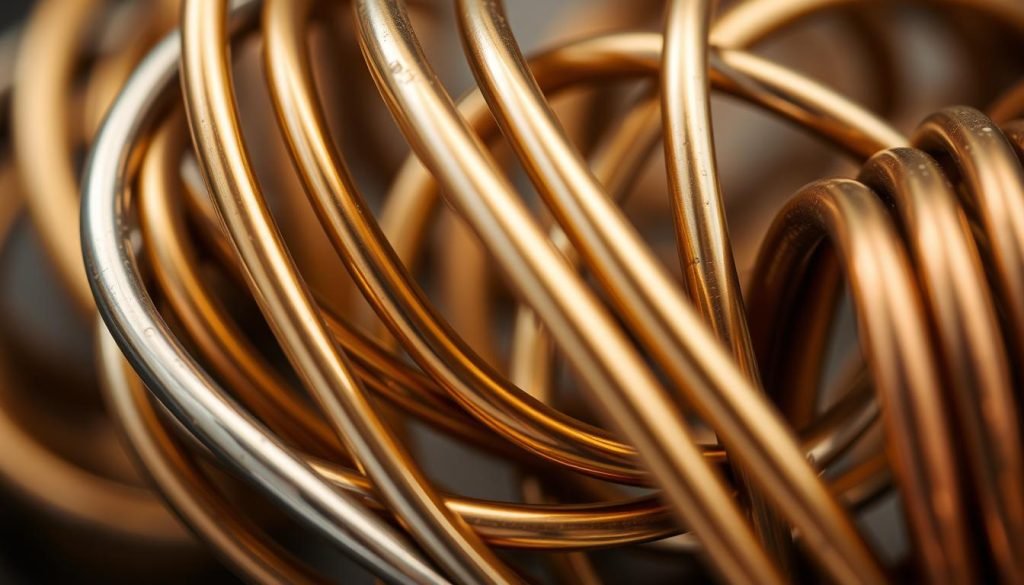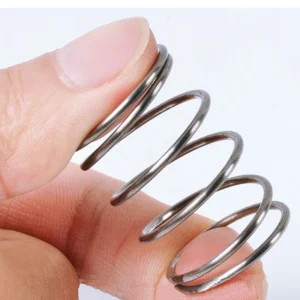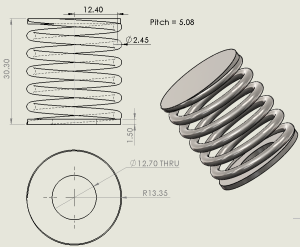Choosing between brass and bronze for springs is key to their performance and life span. Both metals have special qualities that fit different uses. Knowing their differences helps pick the best material for your springs.
What is brass and bronze
Brass and bronze are copper-based alloys but have different brass composition and bronze composition. Brass is made of copper and zinc, while bronze is copper and tin. These differences in metal alloy properties make each metal unique. This uniqueness affects how well they work as spring materials.
Brass is known for its golden-yellow color and high malleability. This makes it great for decorative uses. Bronze, on the other hand, has a reddish-brown color and is stronger and more durable than brass. Both alloys are good at resisting corrosion, conducting electricity, and heat. This makes them popular in many industries and commercial uses.
| Property | Brass | Bronze |
|---|---|---|
| Composition | Copper and Zinc | Copper and Tin |
| Color | Golden-Yellow | Reddish-Brown |
| Strength | Moderate | High |
| Corrosion Resistance | Good | Excellent |
| Malleability | High | Moderate |
“Brass and bronze are both versatile copper-based alloys with distinct properties that make them suitable for a wide range of applications, including the manufacture of high-performance springs.”
It’s important to know the brass composition, bronze composition, and metal alloy properties of these materials. This knowledge helps choose the best spring material for a specific task.
Brass vs Bronze: Key Differences
Brass and bronze are both copper-based alloys, but they differ in important ways. These differences affect their use in springs. Knowing these differences helps choose the right material for your spring needs.
Color and Appearance
The color of brass and bronze is a big difference. Brass looks yellow or golden, while bronze is reddish-brown. This color difference matters for looks in some applications.
Strength and Durability
Bronze is stronger and more durable than brass. It has higher tensile strength and lasts longer under heavy use. This makes bronze better for springs that face tough conditions.
Corrosion Resistance
Corrosion resistance is another area where bronze outshines brass. Bronze resists corrosion better, especially outdoors. This is why bronze is great for springs exposed to moisture or chemicals.
Cost Considerations
Cost-wise, brass is cheaper than bronze. This is key for projects with budget constraints or large production needs.
| Characteristic | Brass | Bronze |
|---|---|---|
| Color | Yellow/Golden | Reddish-Brown |
| Strength | Moderate | High |
| Corrosion Resistance | Moderate | High |
| Cost | Lower | Higher |
Understanding the differences between brass vs bronze helps you pick the best for your spring needs. Consider appearance, performance, and cost in your decision.
Factors Affecting Spring Performance
Several key factors affect spring performance. These include spring strength, durability, and corrosion resistance. The material, like brass or bronze, greatly influences a spring’s performance in various settings.
Strength and Durability
The strength and durability of a spring are vital. They help the spring handle stress and repeated use well. Brass is often chosen for springs needing high strength and lasting performance.
| Property | Brass | Bronze |
|---|---|---|
| Tensile Strength | Higher | Lower |
| Fatigue Resistance | Superior | Good |
| Hardness | Harder | Softer |
Bronze, however, is more flexible. This flexibility is good for springs needing to bend without breaking.
Corrosion Resistance
The corrosion resistance of a spring is key, especially in wet or chemical-rich environments. Bronze is better at resisting corrosion than brass. This makes bronze ideal for outdoor or industrial use.
“Corrosion can significantly compromise the integrity and lifespan of a spring, so the material’s ability to withstand degradation is a critical consideration.”
Knowing brass and bronze’s properties helps engineers choose the right material for springs. They balance spring performance factors like strength, durability, and corrosion resistance.
Brass Springs: Advantages and Disadvantages
Brass springs have both good and bad points compared to other spring materials. Knowing these can help those choosing springs make better choices.
Advantages of Brass Springs
- Excellent corrosion resistance: Brass doesn’t rust or corrode easily. This makes it great for places with moisture, chemicals, or harsh conditions.
- Relatively low cost: Brass is cheaper than metals like stainless steel or beryllium copper. This makes it a budget-friendly choice for many springs.
- Good thermal conductivity: Brass springs can move heat well. This is good for applications where getting rid of heat is important.
- Attractive appearance: The golden color of brass springs can make products or designs look better.
Disadvantages of Brass Springs
- Lower strength: Brass is not as strong as other metals. This might limit its use in high-strength spring applications.
- Potential for stress relaxation: Brass springs can lose some of their initial tightness over time. This can impact their performance.
- Limited temperature range: Brass springs might not work well in very hot or cold temperatures. Their properties can change with temperature.
Brass Spring Applications and Industries
Brass springs are used in many industries because of their special properties. Here are some common uses:
- Automotive: Brass springs are in car parts like fuel pumps, door latches, and suspension systems.
- Electronics: They’re in electronic devices, such as switches, connectors, and contact points. Their resistance to corrosion and conductivity are key here.
- Plumbing and HVAC: Brass springs are in plumbing and HVAC gear, like faucets, valves, and thermostatic controls.
- Furniture and appliances: They’re in furniture, like recliners and mattresses, and in household appliances, like washing machines and dishwashers.
Knowing the good and bad of brass springs helps manufacturers and engineers pick the right spring for their needs.
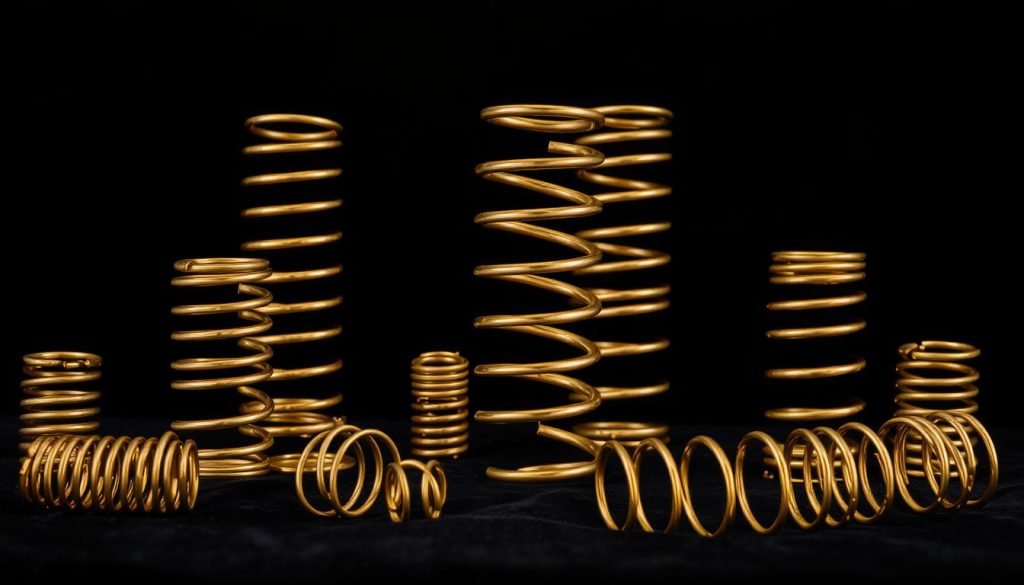
Bronze Springs: Pros and Cons
Brass springs have many benefits, but bronze springs have their own set of advantages and disadvantages. Knowing the specifics of bronze as a spring material can help you choose the best option for your needs.
Advantages of Bronze Springs
- High Strength and Durability: Bronze springs are very strong and last a long time. They’re perfect for tasks that need heavy-duty performance and a long life.
- Corrosion Resistance: Bronze springs resist corrosion well. This makes them great for places where moisture, chemicals, or other corrosive elements are present.
- Aesthetic Appeal: Bronze springs have a warm, golden color. This adds elegance and beauty to various products and designs.
Disadvantages of Bronze Springs
- Higher Cost: Bronze springs are pricier than brass springs. This can be a big deal, especially for big orders or high-volume production.
- Limited Corrosion Resistance: While bronze springs resist corrosion better than some materials, they might not protect as well as stainless steel or other alloys in very corrosive environments.
- Increased Density: Bronze is denser than brass. This means bronze springs can be heavier. This might be a problem for applications where weight is important.
In summary, bronze springs are strong, durable, and look good. But, they cost more and might not be as good at resisting corrosion or being light. Thinking about the pros and cons can help you decide if bronze springs are right for you.
| Advantages of Bronze Springs | Disadvantages of Bronze Springs |
|---|---|
| High Strength and Durability | Higher Cost |
| Corrosion Resistance | Limited Corrosion Resistance |
| Aesthetic Appeal | Increased Density |
Brass vs Bronze: Who is Better for Springs?
Comparing Performance and Cost-Effectiveness
Choosing between brass and bronze for springs is not easy. It depends on what you need, like strength, resistance to corrosion, and cost. Each material has its own strengths.
Brass springs are strong and last long, great for heavy loads. Bronze springs resist corrosion well, perfect for wet or chemical environments.
| Performance Metric | Brass Springs | Bronze Springs |
|---|---|---|
| Strength and Durability | Higher | Lower |
| Corrosion Resistance | Lower | Higher |
The cost of brass and bronze springs also matters. Brass springs are often cheaper because brass is less expensive. But, the final cost depends on many things, like how much you need and where you buy it.
“The choice between brass and bronze springs ultimately comes down to a balance of performance requirements and cost-effectiveness for the given application.”
Deciding between brass and bronze springs needs careful thought. Look at what your application needs, like strength, corrosion resistance, and cost. This way, you pick the best spring material for your project.
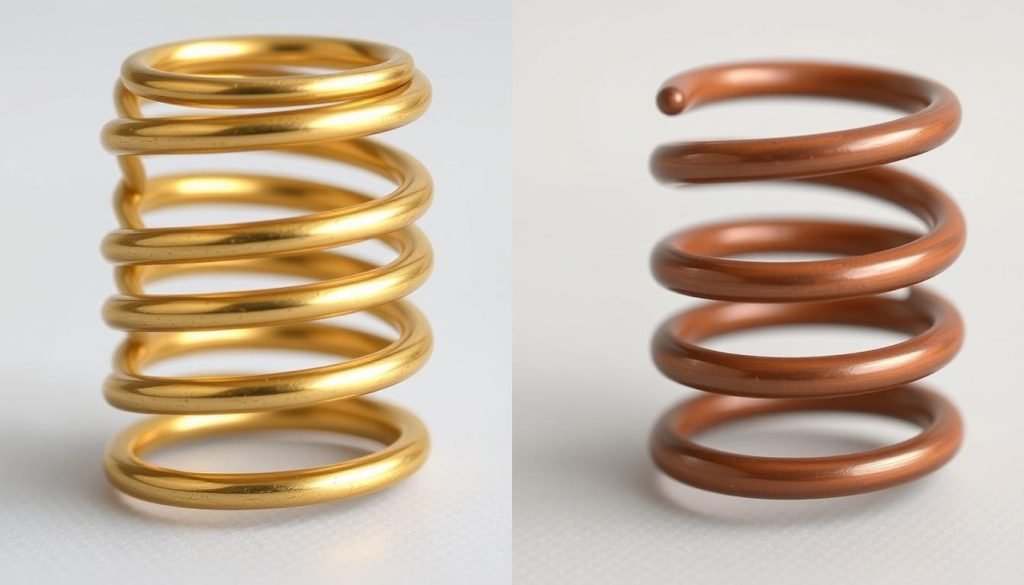
Maintenance and Care for Brass and Bronze Springs
Keeping brass and bronze springs in good shape is key to their long life and best performance. The same care tips apply to both brass spring maintenance and bronze spring maintenance.
Here are some important tips to keep your springs in top condition:
- Regular Cleaning: Use a soft, lint-free cloth to wipe down the springs. This removes dirt and debris. Avoid harsh cleaners that can harm the springs.
- Lubrication: Apply a small amount of high-quality lubricant to the springs. Focus on moving parts and contact points. This reduces friction and extends the springs’ life.
- Proper Storage: Store the springs in a clean, dry place. Keep them away from sunlight, moisture, and extreme temperatures. This prevents damage and keeps the materials intact.
- Periodic Inspection: Check the springs regularly for wear, damage, or corrosion. Fix any problems quickly to keep them working well.
| Maintenance Aspect | Brass Springs | Bronze Springs |
|---|---|---|
| Cleaning | Gentle wiping with a soft cloth | Gentle wiping with a soft cloth |
| Lubrication | Corrosion-resistant lubricant | Corrosion-resistant lubricant |
| Storage | Clean, dry environment | Clean, dry environment |
| Inspection | Regular check for wear and corrosion | Regular check for wear and corrosion |
By following these brass spring maintenance and bronze spring maintenance tips, you can keep your springs in great shape. This ensures they work well for a long time.
Environmental Considerations
Choosing the right spring materials is key today. Both brass springs and bronze springs have their own eco-friendly sides. Let’s dive into their sustainability and recyclability.
Sustainability and Recyclability
Brass, made mostly of copper and zinc, is seen as a green choice. It can be recycled many times without losing quality. This makes brass springs a top pick for those caring about the planet.
Bronze springs also shine in the sustainability department. Bronze, a mix of copper and tin, can be recycled endlessly. This cuts down on waste and saves resources, highlighting the recyclability of bronze.
| Material | Sustainability | Recyclability |
|---|---|---|
| Brass | Highly sustainable due to recyclability | Brass can be recycled repeatedly without losing its properties |
| Bronze | Sustainable due to recyclability | Bronze can be recycled and reused indefinitely |
Both brass and bronze springs are better for the environment than some other options. But, we must think about their whole life cycle. From making to recycling, every step matters. Good sourcing, eco-friendly making, and recycling help make these springs even greener.
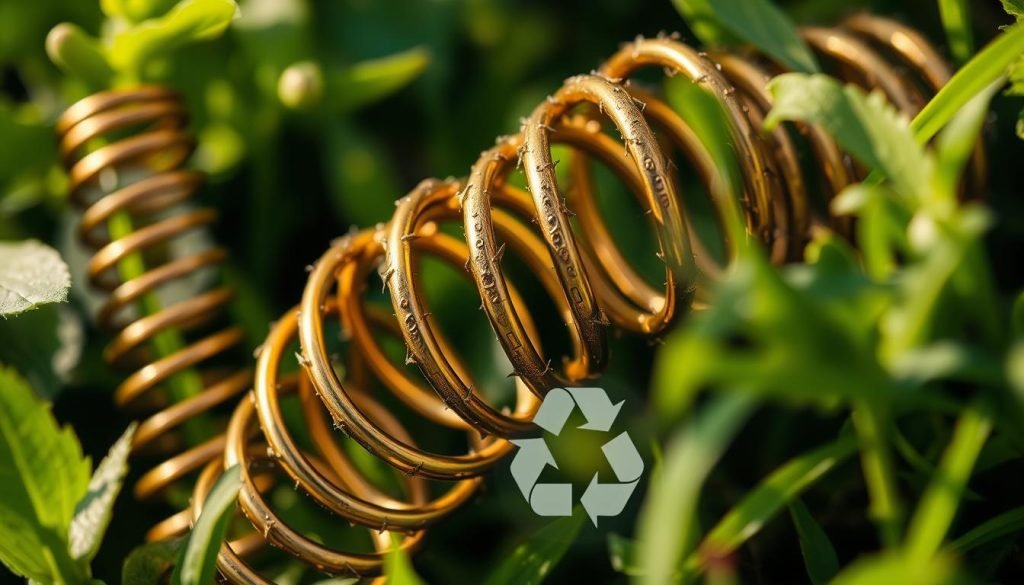
“Sustainability and recyclability are crucial considerations in modern manufacturing, and the spring industry is no exception. Brass and bronze offer distinct advantages in this regard, making them attractive options for environmentally conscious consumers and businesses.”
Future Trends and Innovations
The world of engineering and manufacturing is always changing. The future of brass and bronze springs looks very promising. New materials and production methods could change how these springs are made and used.
Researchers are working on new spring material formulations. They aim to make brass springs and bronze springs stronger and more durable. This could lead to springs that last longer and work better in different situations.
There’s also a focus on making springs more eco-friendly. As companies try to reduce their environmental impact, springs made from recycled or green materials might become more common. This could help cut down on waste and make recycling easier.
| Anticipated Innovations | Potential Benefits |
|---|---|
| Advanced alloy formulations | Improved strength, durability, and corrosion resistance |
| Sustainable manufacturing processes | Reduced environmental impact and increased recyclability |
| Integrated sensor technology | Enhanced monitoring and predictive maintenance capabilities |
The use of sensor technology in springs could be a game-changer. Smart sensors could give real-time updates on a spring’s condition. This would help prevent breakdowns and keep things running smoothly.
“The future of brass and bronze springs is poised to be shaped by advancements in material science, sustainability, and the integration of cutting-edge technologies. These innovations will undoubtedly enhance the durability, efficiency, and versatility of these essential components across a wide range of industries.”
The future of brass springs, future of bronze springs, and spring material innovations will be key in the next era of engineering. They will help create better solutions for many industries.
Choosing the Right Material for Your Spring Needs
Choosing the right material for your springs involves several factors. These include the specific needs of your application, performance, and cost. The decision between brass and bronze can greatly affect your project’s success. Let’s look at the important things to consider when picking the best spring material.
Performance Requirements
The main thing to think about is what your spring needs to do. Look at things like:
- Strength and durability
- Corrosion resistance
- Flexibility and spring rate
- Operating temperature range
Based on your spring’s function, one material might be better than the other. Make sure to analyze your needs well to choose the best one.
Cost Considerations
Cost is also very important. Brass is usually cheaper than bronze, which is good for your budget. But, bronze’s long-lasting durability and resistance to corrosion might be worth the extra cost in some cases.
| Factors to Consider | Brass | Bronze |
|---|---|---|
| Cost | Lower | Higher |
| Strength and Durability | Good | Excellent |
| Corrosion Resistance | Moderate | Superior |
By considering what matters most for your spring, you can decide if brass or bronze is better for you.
“The key to selecting the right spring material is to balance performance requirements with cost considerations, ensuring the optimal solution for your project.”
Conclusion
Brass and bronze have their own strengths for springs. Brass is tough and affordable, great for everyday springs. Bronze, however, is top-notch for fighting corrosion and lasting long, perfect for tough spots.
When you compare brass vs bronze springs, you can pick the best for your needs. Whether you need something strong, long-lasting, or budget-friendly, the right choice can boost your system’s performance and life.
The debate between brass and bronze will keep growing as technology advances. Keeping up with new info helps you make smart choices for your springs. This way, your springs will meet the latest engineering and manufacturing needs.
FAQ
What are the main differences between brass and bronze?
Brass is made of copper and zinc. Bronze is made of copper and tin. These differences affect their color, strength, and how well they resist corrosion. They also impact their cost.
Which material is better for springs, brass or bronze?
Choosing between brass and bronze for springs depends on your needs. Consider the strength, corrosion resistance, and cost you need.
What are the advantages and disadvantages of brass springs?
Brass springs resist corrosion well and are affordable. However, they might not be as strong as other metals. They’re used in many industries and applications.
What are the pros and cons of bronze springs?
Bronze springs are very strong and durable. But, they cost more and might not resist corrosion as well as brass.
How should brass and bronze springs be maintained and cared for?
To keep brass and bronze springs working well, clean them, lubricate them, and store them properly. This helps them last longer and perform better.
What are the environmental considerations for brass and bronze springs?
When choosing spring materials, think about sustainability and recyclability. Both brass and bronze have good environmental profiles. But, their overall impact should be considered.
What future trends and innovations are expected in the world of brass and bronze springs?
As technology and manufacturing improve, we might see new uses for brass and bronze springs. This could change how they perform and their cost.
How can I choose the right material for my spring needs?
To pick the right material for your springs, think about what your application needs. Consider performance and cost. Knowing the unique qualities of brass and bronze can help you decide.

